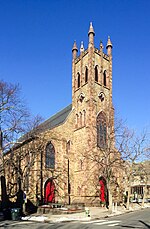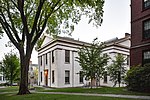Nelson W. Aldrich House
Federal architecture in Rhode IslandHistoric American Buildings Survey in Rhode IslandHistoric house museums in Rhode IslandHistorical society museums in Rhode IslandHouses completed in 1821 ... and 5 more
Houses in Providence, Rhode IslandHouses on the National Register of Historic Places in Rhode IslandMuseums in Providence, Rhode IslandNational Historic Landmarks in Rhode IslandNational Register of Historic Places in Providence, Rhode Island

The Nelson W. Aldrich House, also known as the Dr. S. B. Tobey House, is a Federal-style house at 110 Benevolent Street in the College Hill neighborhood of Providence, Rhode Island. The house was the home of Nelson W. Aldrich, a U.S. Senator from 1881 to 1911. Aldrich was a dominant and controversial figure in the Senate, exercising significant control over the legislative process. This house, one of two surviving properties associated with Aldrich, was declared a National Historic Landmark in 1976. It is now a house museum operated by the Rhode Island Historical Society.
Excerpt from the Wikipedia article Nelson W. Aldrich House (License: CC BY-SA 3.0, Authors, Images).Nelson W. Aldrich House
Benevolent Street, Providence
Geographical coordinates (GPS) Address Nearby Places Show on map
Geographical coordinates (GPS)
| Latitude | Longitude |
|---|---|
| N 41.8253 ° | E -71.3957 ° |
Address
Grant-Fulton
Benevolent Street 105
02912 Providence
Rhode Island, United States
Open on Google Maps









